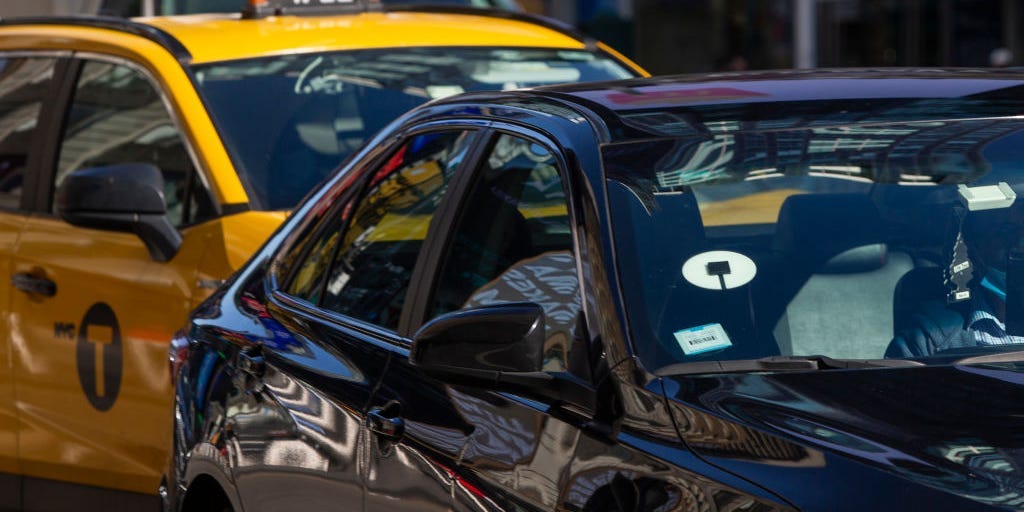- Many gig drivers lured by the flexibility of gig work say the flexibility of their job is often limited.
- Drivers for Uber and Lyft who rely on the income often find they must drive during high-demand periods.
- Some drivers say the best rides in their area are at 5 a.m. or 9 p.m.
Thanks for signing up!
Access your favorite topics in a personalized feed while you’re on the go.
download the app

Many drivers for Uber, Lyft, and other rideshare and delivery apps say they value the flexibility of gig work over any other component. But that flexibility can be limited — drivers often need to work early mornings or late nights to get more profitable rides.
Some gig drivers have recently told Business Insider that because they rely on driving for most or all of their income, deciding when to drive is less of a choice. For instance, Starla, 27, is a single parent who sometimes has to drive 16 hours a day for Uber Eats to provide for her eight-year-old in Jacksonville, Florida. She sometimes drives overnight shifts or late nights on weekends to make ends meet.
For some drivers, the best rides in their area are at 5 a.m. or 9 p.m., while other drivers say midday is most optimal. For drivers with disabilities, single parents, veterans, and others, making enough money to pay bills requires sacrificing family time or other life events.
“The companies’ main selling point is their flexibility, turn your app on whenever you want and make some money,” Sergio Avedian, Senior Contributor at The Rideshare Guy, told BI. “The caveat in that is making some money.”
Many part-time drivers have previously told BI they value gig driving for the ease with which they could supplement their core income. Some drivers only put in 10 to 20 hours a week at their leisure, whether it’s after work or on weekends. Some can pull in a few hundred dollars a week to supplement their main income.
“I think the part-timers still do appreciate the flexibility aspect,” Avedian said. “If you’re a soccer mom, you drop your kids off at school, you can do rideshare for a couple hours before you pick them up. But are you going to be profitable, or are you just wearing your car out or basically falling into the trap of flexibility?”
Lyft announced in February it would guarantee weekly earnings for drivers at 70% or more of what riders paid after taking into account external fees such as local taxes. Lyft noted that the typical US driver earned about $23 per engaged hour — or hours spent picking up or dropping off customers — after expenses. Lyft said about 15% of drivers earn less than 70% or more of their weekly rider payments.
Uber hasn’t announced specific policies like this, though the typical US driver earned about $33 per engaged hour before driving expenses, per an announcement in November.
Flexibility can be an illusion
But for the minority of drivers who drive full-time, many of whom cannot work a 9-to-5 job, flexibility may be an illusion, said Lindsey Cameron, an assistant professor of management at the Wharton School who studies algorithms and the gig economy.
“Drivers talk about how they’re having to work more hours to earn the same amount of money, not actually having that schedule flexibility,” Cameron told BI. “In actuality, for those economically dependent on this work, like to make your child support payments, you’ve got to go when there’s high-demand times. Schedule flexibility at times can be a myth when you’re economically dependent on that work.”
Schedule flexibility allows people with disabilities, for instance, to drive around chemotherapy appointments or school drop-offs. However, Cameron added that drivers who are more financially dependent on these apps are more likely to accept lower fare amounts as they need the money.
Many drivers are lured into gig work by promises of flexibility, though Avedian said growing competition has made it so that more profitable rides are harder to secure.
“Flexibility and freedom was a massive selling point because the demand was outstripping supply, but for the last three, four years, that’s kind of out of the window,” Avedian said. “The reason for that is every single market that I know of is extremely oversaturated.”
Working on their own terms
Still, many drivers would rather work on their own terms than have a set work schedule. Laura Katsnelson, a doctoral candidate in the Strategy Unit at Harvard Business School, told BI that gig drivers “derive substantial value from being able to change which hours they work from week to week,” though demand conditions likely impact when drivers choose to work.
In her paper “Being the Boss: Gig Workers’ Value of Flexible Work,” she and her colleague Felix Oberholzer-Gee found that when the average DoorDash driver is forced to work exclusively in their most frequently driven blocks of time, hourly earnings are cut by over 11%. Given this arrangement, over two-thirds would be projected to drop out.
“We assume that if they chose a particular time to work on the platform, it’s because it made the most sense for them given their set of circumstances at the time,” Katsnelson said. “However, it may very well be that certain drivers would prefer a world in which they could work a 9-5 job with employee benefits that pays ‘enough’ for them to get by. On the other hand, there are likely other subsets of drivers who are well-served by the current DoorDash model because they use it to flexibly supplement their income.”
Chasing more lucrative rides
Katie Wells, a geographer at Georgetown University and author of “Disrupting DC: The Rise of Uber and the Fall of the City,” said that in her research, many drivers said they would arrange their schedules around the hopes of encountering incentives offered by platforms like bonuses, sometimes working split shifts. This helps them maximize their earnings, but many feel like it’s their only option.
Some drivers told her they would work 16-hour overnight shifts on weekends to find higher-paying, better-tipped rides. She said one driver worked from 7 a.m. to 10 a.m., then from 4 p.m. to 10 p.m., because he could only make a profit during these periods. He was “free” to choose his schedule, Wells said, but driving whenever he pleased would mean fewer profitable rides.
“The flexibility of the gig economy is a mirage, and quite a costly one,” Wells said. “Uber and its peers appeal to workers with oodles of promises that workers can hold the power to control their work hours. However, the reality for too many workers in too many cities for more than a decade is far from that ideal. Many gig workers end up working much longer hours than they hope, trying to eke out decent earnings.”
For Avedian, who also drives part-time, driving during peak hours often doesn’t equate to higher earnings. Avedian estimated his utilization rate is 50%, meaning for every hour online, he only gives rides for half an hour. He estimates that for a Saturday driving from 10 a.m. to 6 p.m. in Los Angeles, his gross earnings are $21 an hour before expenses.
“If you work between 10 a.m. and 2 p.m., there’s no flexibility because everybody’s already at school, at work. There are no trips out there, and you’re just going to sit there,” Avedian said. “In order for you to maximize your earnings, you have to work when and where there is demand. What kind of flexibility is that if I turn my app on at 2 a.m.? Do you think I’m going to make some money? I don’t think so.”
Are you a ride-hailing driver who’s struggling to pay bills or has had recent success? If you’d like to share your story, reach out to nsheidlower@businessinsider.com.


